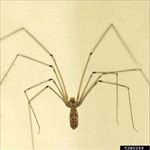Color: Pale yellow to light brown or gray
Legs: 8
Shape: Long skinny legs with a small body
Size: 1/4-3/8” (6-9mm)
Antennae: False
Region: Found throughout U.S.
Cellar spiders are commonly referred to as “daddy-long-legs” because of their very long, thin legs and as their name implies are found in dark and damp places. There are about 20 species of cellar spiders in the United States and Canada.
Habits
Cellar spiders build loose, irregular, tangled webs in corners. They hang upside down on the underside of the web. The webs are not cleaned but instead a new web is continually added. This habit can result in extensive webbing in a relatively short time.
Habitat
The spiders and their webs are usually found in dark and damp places, such as cellars, basements, and crawl spaces. They can also be found in the corners of garages, sheds, barns, and warehouses, on eaves, windows, and ceilings, and in closets, sink cabinets, and bath-traps. Cellar spiders seem to fare better in areas with higher relative humidity,
Threats
Cellar spiders do not pose a threat to humans. While they are commonly found in homes, they usually stay in one place. They are not known to bite. Urban legend has it that their venom is of the most deadly of spiders, but their weak mouthparts keep them from injecting venom into humans. While it is correct that they cannot successfully bite, their venom is not very potent.
Prevention:
Seal cracks on the outside of the home, especially around doors and windows, and use screens to prevent entry into homes. Using yellow light bulbs for exterior lighting may reduce the number of spiders and other insects as they are typically attracted to white-light sources. Additionally, lowering the humidity in basements, cellars and crawl spaces with the use of a dehumidifier or ventilation can discourage cellar spiders from living there.
Source: https://www.pestworld.org/
